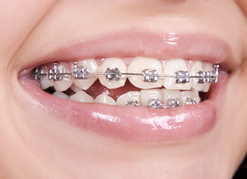Dental Braces

Orthodontic braces, or simply braces are appliances used to help align and straighten teeth. Braces allows the orthodontist to treat malocclusions (unhealthy bite and irregular teeth) improving dental health and giving designer smiles. Braces can be either cosmetic or structural. Dental braces or orthodontic braces are often used along with other orthodontic appliances to help widen the palate or jaws and to otherwise assist in shaping the teeth and jaws.
How braces work
 The braces moves the teeth by applying mild force and pressure on the teeth. When mild force are conveyed threw the arch wires engaged on to the bracket bonded teeth the teeth move. Rubber bands or springs are used to apply constant presssure in a specific direction. Thereby moving teeth into their desired positions.
The braces moves the teeth by applying mild force and pressure on the teeth. When mild force are conveyed threw the arch wires engaged on to the bracket bonded teeth the teeth move. Rubber bands or springs are used to apply constant presssure in a specific direction. Thereby moving teeth into their desired positions.
Types of braces
Ceramic braces, Metal metal, Self-legating brackets?
These days you are spoiled for choice in choosing your brackets and it gets confusing! Which type of braces should you choose? Can you choose, or is it strictly up to your orthodontist. Ideally it should be a joint decision where your social requirements are met and the orthodontist treatment objectives can be achieved.
Tooth Colored Braces
Tooth Colored Braces can be either Ceramic or Composite
Ceramic brackets are stronger and generally do not usually stain. Three popular brands are Clarity and Transcend, made by 3M Unitek and Allure from TP orthodontics; Adults like to choose ceramic because they "blend in" with the teeth and are less noticeable than metal.
Composite brackets are not as strong as ceramic and they tend to take on stains faster and they are comparatively cheaper.
Metal braces
Metal braces are the most commonly used in orthodontic treatment, and are made of a alloy of stainless steel, nickel and various other metals in small amounts. There are different variations of these brackets both in shape, size and prescription but all have the same characteristic of having 'wings', and a slot for the wire around which a ligature or elastic module is used to hold the orthodontic wire in place.
Elastic ties or modules come in several different colors and are responsible for the braces colors seen on young patients' teeth. These types of braces allow the wire to be tied in very tightly to the bracket, allowing excellent control in aligning crooked teeth. Generally, the metal braces cost less compared to ceramic or cosmetic braces.
Self-ligating braces
Self-ligating braces function are similar to traditional orthodontic braces in their material but have a inbuilt locking system. As with traditional metal braces, there are several variations of self-ligating braces. Self-ligating means that the bracket can lock the archwire in place.
There are no metal or elastic ties necessary with self-ligating braces as a built in 'locks' that can be slid or flipped closed to engage the wire. This lock holds the wire loosely in position, which reduces friction, but also allows less control of tooth movement
Aligners
Aligners are a series of highly transparent splints which are designed in such a way to bring about tooth movement .The advantages of the aligners are that duration between checkups are longer and the patient can be educated on the timing of each aligner thereby allowing patients to have treatment even in places where they don't have access to an orthodontist.
Retainers
In order to prevent the teeth from moving back to their original position, retainers have to be worn once the treatment with braces is complete for the patient depending on their specific requirement. If the patient does not wear the retainers appropriately for the right amount of time, the teeth may relapse to their previous position.
Hawley retainers are used traditionally. They are made of metal clasps and a labial archwire that surround the teeth which are kept in place by an acrylic plate moulded to fit the patient's palate.
Bonded retainer: Here a wire is permanently bonded to the lingual side of the teeth this is especially usefull in case when there was lots of space between the teeth or when the teeth were severely crowded before treatment.
Functional Orthodontics
Functional orthodontics here appliances like headgears, facebows, twinblocks are used to restrict,modify, redirect or propagate growth of the perioral skeletal structures to get a aesthetic balance for the facial bones and a stable bite
